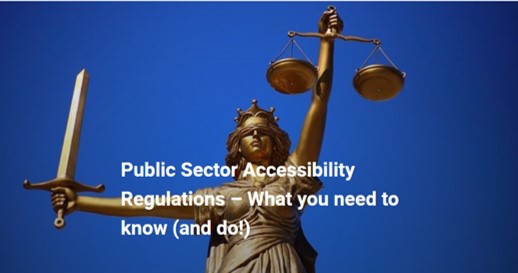We partnered with Jisc’s accessibility specialist Kellie Mote to deliver the webinar ‘Public Sector Accessibility Regulations – What you need to know (and do!)’. It was a very popular session with 138 signed up to attend. It was a very engaging session and we had an extended discussion before and after the recorded part of the webinar, which covered a lot of the challenges facing public sector organisations.
As there’s an approaching deadline of September 2020 for existing websites (internal and external) to meet the Regulation’s WCAG 2.1 AA standard, we thought it would be a good idea to share Kellie’s presentation with the widest possible audience.
Below you’ll find the recording we put on YouTube (around 30 minutes); we also used Vimeo when we were experimenting with caption options (you can find out more below):
A survey
During the webinar, Kellie posted a few survey questions asking about confidence levels and preparedness for the Regulations deadlines. Kellie has come up with a few more questions which she would deeply appreciate you taking a few minutes to complete. This helps with her planning events and resources to meet actual demand. Complete Kellie’s survey questions here; the survey will remain open until the 13th of March.
Useful links and resources
You can view Kellie’s slides on SlideShare or download Kellie’s slides directly from here. A number of useful resources were mentioned during the webinar, although not exhaustive, a number of links can be found below:
• Jisc’s advice on meeting accessibility regulations
• EdX’s Introduction to Web Accessibility course
• Jisc’s Accessibility Drop-in Clinic
• George Rhodes’s Twitter feed
• Buxton & Leek College Accessibility Statement
• Jisc’s Accessibility Community Group
Kellie also mentioned a number of organisations that offered auditing services (these come at a cost):
• AbilityNet
• AllAble
• Digital Accessibility Centre
Finally, Helen Wilson from Worcestershire County Council shared her SCULPT resources, guides to promoting simple steps to developing accessible content which are available under a Creative Commons licence. They looked pretty good to me and while they may not get you to the Regulation standards, they offer a practical first step which is more likely to be adopted by a wider audience. It’s all about moving in the right direction.
More about transcriptions
The YouTube recording includes captions which were generated automatically by the YouTube service. I wanted to use the experience to see how other transcription services might compare, so uploaded the video to Vimeo only to discover that no free transcription service was available – though you could add your caption script. I had a try with Microsoft Stream (available via Office365), but discovered that although you can generate captions, there’s no option to share the video with an external audience. This functionality was supposed to be available Q4 2019, but has been pushed back to Q4 2020. However, I was able to download the caption script as a .vtt file and upload that to Vimeo. Here’s the result:
Not to be outdone, Kellie also transcribed the session using the Otter ai transcription app on her phone; there’s a generous free plan, so it’s worth checking out. The service produces a transcript file (but not in the format that can be uploaded as captions); check out the transcript that Kellie shared from the Otter ai service.
Okay, I think that covers everything for now. We have organised a follow-up workshop at the CDN offices in Stirling on the 24th of March led by Kellie, but last time I looked, it was fully booked. We are looking at how we might offer more support in this area, so please keep checking the Courses and events section of our website for upcoming opportunities.
If there’s one thing you should do after reading this, I would suggest joining Jisc’s Accessibility Community Group. There are just under 350 participants in the MS Teams group and a wealth of information being shared between community members. If you have a question or want to follow up with us here at CDN, please feel free to drop me (Kenji) an email. Chances are I’ll be googling for an answer or calling Kellie for help, but we’re always happy to hear from you!
A final note (and admission)
At CDN, we recognise the challenges of meeting the new regulations as we review and update and digital content before the September 2020 deadline. On this website, you will discover a number of issues that we have still to address. For example, at the top of this page, our WordPress platform is set up to display the title of the page over a custom image:
As you might imagine, this isn’t an accessible way of presenting text – depending on the size of screen you’re viewing this on, it can make it difficult for an able-sighted person to read. The only practical solution to this is to replace the background image with a solid colour; we’re just leaving it like this at the moment as an example. In the future, we will ensure text is placed on a solid box with an appropriate background colour, which allows us to continue using images.
Default text colour for pages vs. Compliant text colour (contrast)
Another challenge we faced on this page was that text defaulted to a dark(ish) grey on a light grey background, so we had to adjust the text to a black to meet the contrast guidelines. We’re going to look at how we embed an accessible approach to content development. It’s a work in progress, and we hope we’re moving in the right direction!






